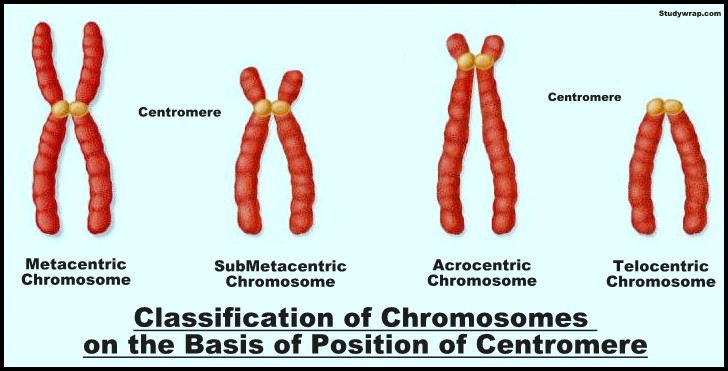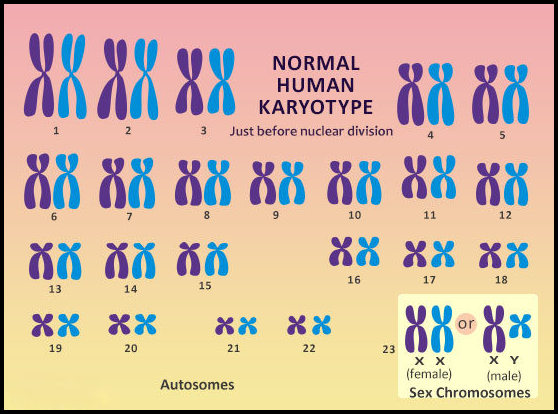Science
Shapes of Chromosome and its Function, Karyotype
Shapes of Chromosome and its Function & Karyotype
Table of Contents
What are Chromosomes ?
- Chromosomes are string-like structures located inside the nucleus of the cells.
- Chromosomes are thread-like structures in which DNA is tightly packaged within the nucleus.
- Chromosome is derived from the Greek words “chromo” meaning colour and “soma” meaning body.
- They got this name because Chromosomes become strongly stained when colourful dyes are applied to them.
Chromosome Number
- Chromosome number remains constant in all the cells of an individual of a same species.
- There is two type of Chromosome Numbers –
- Diploid Chromosomes – refers to somatic chromosome number of a species and is represented by 2n. They have two sets of Chromosomes one from each parents.
- Haploid Chromosomes – represents half of the somatic chromosome number of a species and is denoted by n. They have only one set of Chromosomes. They are present in Gametes or the reproductive cells.
Shapes of Chromosome
- Chromosome Shape can be determined by number of ways which includes –
a. As observed during Anaphase
b. On the basis of position of Centromere
c. On the basis of Role in Sex Determination
d. On the basis of Number of Centromere
1. Shapes of Chromosomes on the basis of position of Centromere
a. Telocentric Chromosome
-
-
- These rod shaped Chromosomes have centromere at terminal position so that they possess only one arm.
-
b. Acrocentric Chromosome
-
-
- They have sub terminal Centromere. In this type, one arm is very long, and other is very short. These chromosome appears J-shaped.
-
c. Sub-metacentric Chromosome
-
-
- Chromosome with Centromere slightly away from the mid point so that two arms are unequal. These are L-shaped.
-
d. Metacentric Chromosome
-
-
- Chromosomes with Centromere at the middle of Chromosome. They have almost equal arms. They are V-shaped.
-
2. Shapes of Chromosome as observed during Anaphase
a. V Shaped Chromosome
-
-
- Chromosome which assumes V shape at anaphase. It includes metacentric chromosome.
-
b. J Shaped Chromosome
-
-
- Chromosome which assumes J shape at anaphase. It includes sub-metacentric and sub-terminal chromosomes.
-
c. Rod Shaped Chromosome
-
-
- Chromosome which assumes rod like shape during anaphase. It includes telocentric chromosome.
-
3. Types of Chromosomes on the basis of Role in Sex Determination
a. Allosomes or Sex Chromosomes
-
-
- Chromosomes which differ in morphology and number in male and female sex and contain sex determining genes. They are generally of two types, viz., X and Y or Z and W types.
- Responsible for development of Sex.
-
b. Autosomes
-
-
- Chromosomes which do not differ in morphology and number in male and female sex and rarely contain sex determining genes.
- Responsible for somatic characters.
-
4. On the basis of Number of Centromere
a. Acentric Chromosome
-
-
- A chromosome without centromere. Such chromosome remains as laggard during cell division and is eventually lost.
-
b. Monocentric Chromosome
-
-
- A chromosome with one centromere. It represents normal type of chromosomes.
-
c. Dicentric Chromosome
-
-
- A chromosome having two centromeres. Such chromosome makes dicentric bridge at anaphase and are produced due to inversion and translocations.
-
Karyotype
- Karyotype refers to the characteristic features of chromosomes of a species. In other words, karyotype is a phenotypic appearance of chromosomes of a particular species.
- The karyotype is represented by gametic chromosome number.
- In the study of karyotype, various features of chromosomes are taken into account,
-
- Number
- Size
- Position of centromere
- Degree & distribution of heterochromatin.
-
- The karyotype is generally identical for a species, but it differs from species to species.
Types of Karyotype
-
- Symmetrical Karyotype – chromosomes have median or sub-median position of centromere and less variation in the size of chromosomes.
- Asymmetrical Karyotype – chromosomes have sub terminal centromere and show wide variation in the size of the smallest and the longest chromosome.
Uses of karyotype
-
- The karyotypes of different species are sometimes compared and similarities in karyotypes are presumed to represent evolutionary relationship.
- Study of karyotype helps in understanding the evolutionary process.
- It also suggests primitive or advanced features of an organism.
Idiogram
-
-
- A diagrammatic representation of a karyotype of a species is called idiogram.
- In an idiogram, the chromosomes of a haploid set of an organism are ordered in a series of decreasing size.
-
Function of Chromosome
- Considered as physical basis of inheritance.
- Chromosomes contain genes and their behaviour during meiosis is the physical basis of Mendelian laws of heredity.
- Chromosomes controls metabolism and other activities of cells by directing synthesis of required proteins.
- Chromosomes direct various life processes such as cell growth, cell division and cell repair.
- They guide cell development and cell differentiation.
- Chromosomes determine the sex of an organism.
So, this was all about the Shapes of Chromosome and its Function & Karyotype. To read more on Biology – Click Here.
In the Next Post (Click Here), we will discuss about the Nucleic Acid present in the cell.





really good article!